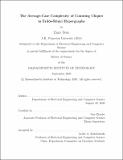| dc.contributor.advisor | Guy Bresler. | en_US |
| dc.contributor.author | Boix, Enric. | en_US |
| dc.contributor.other | Massachusetts Institute of Technology. Department of Electrical Engineering and Computer Science. | en_US |
| dc.date.accessioned | 2021-01-06T19:36:13Z | |
| dc.date.available | 2021-01-06T19:36:13Z | |
| dc.date.copyright | 2020 | en_US |
| dc.date.issued | 2020 | en_US |
| dc.identifier.uri | https://hdl.handle.net/1721.1/129260 | |
| dc.description | Thesis: S.M., Massachusetts Institute of Technology, Department of Electrical Engineering and Computer Science, September, 2020 | en_US |
| dc.description | Cataloged from student-submitted PDF version of thesis. | en_US |
| dc.description | Includes bibliographical references (pages 77-82). | en_US |
| dc.description.abstract | The complexity of clique problems on Erdős-Rényi random graphs has become a central topic in average-case complexity. Algorithmic phase transitions in these problems have been shown to have broad connections ranging from mixing of Markov chains and statistical physics to information-computation gaps in high-dimensional statistics. We consider the problem of counting k-cliques in s-uniform Erdős-Rényi hypergraphs G(n, c, s) with edge density c and show that its fine-grained average-case complexity can be based on its worst-case complexity. We give a worst-case to average-case reduction for counting k-cliques on worst-case hypergraphs given a blackbox solving the problem on G(n, c, s) with low error probability. Our approach is closely related to [Goldreich and Rothblum, FOCS18], which showed a worst-case to average-case reduction for counting cliques for an efficiently-sampleable distribution on graphs. Our reduction has the following implications: -- | en_US |
| dc.description.abstract | Dense Erdős-Rényi graphs and hypergraphs: Counting k-cliques on G(n, c, s) with k and c constant matches its worst-case complexity up to a polylog(n) factor. Assuming ETH, it takes n(superscript [omega](k) time to count k-cliques in G(n, c, s) if k and c are constant. -- | en_US |
| dc.description.abstract | Sparse Erdős-Rényi graphs and hypergraphs: When c = [theta](n⁻[superscript alpha]), for each fixed [alpha] our reduction yields different average-case phase diagrams depicting a tradeoff between runtime and k. Assuming the best known worst-case algorithms are optimal, in the graph case of s = 2, we establish that the exponent in n of the optimal running time for k-clique counting in G(n, c, s) is wk/3 - C[alpha](k 2) + [omicron][subscript k,[alpha]](1), where w/9 </= C </= 1 and w is the matrix multiplication constant. In the hypergraph case of s >/= 3, we show a lower bound at the exponent of k - [alpha](k s) + [omicron][subscript k,[alpha]](1) which surprisingly is tight against algorithmic achievability exactly for the set of c above the Erdős-Rényi k-clique percolation threshold. Our reduction yields the first average-case hardness result for a problem over Erdős-Rényi hypergraphs based on a corresponding worst-case hardness assumption. | en_US |
| dc.description.abstract | Moreover, because we consider sparse Erdős-Rényi hypergraphs, for each n, k, and s we actually have an entire family of problems parametrized by the edge probability c and the behavior changes as a function of c; this is the first worst-to-average-case hardness result we are aware of for which the complexity of the same problem over worst-case versus average-case inputs is completely different. We also analyze several natural algorithms for counting k-cliques in G(n, c, s) that establish our upper bounds in the sparse case c = [theta](n⁻[superscript alpha]). The ingredients in our worst-case to average-case reduction include: (1) several new techniques for the self-reducibility of counting k-cliques as a low-degree polynomial; and (2) a finite Fourier analytic method to bound the total variation convergence of random biased binary expansions to the uniform distribution over residues in F[subscript p]. | en_US |
| dc.description.statementofresponsibility | by Enric Boix. | en_US |
| dc.format.extent | 82 pages | en_US |
| dc.language.iso | eng | en_US |
| dc.publisher | Massachusetts Institute of Technology | en_US |
| dc.rights | MIT theses may be protected by copyright. Please reuse MIT thesis content according to the MIT Libraries Permissions Policy, which is available through the URL provided. | en_US |
| dc.rights.uri | http://dspace.mit.edu/handle/1721.1/7582 | en_US |
| dc.subject | Electrical Engineering and Computer Science. | en_US |
| dc.title | The average-case complexity of counting cliques in Erdős-Rényi Hypergraphs | en_US |
| dc.type | Thesis | en_US |
| dc.description.degree | S.M. | en_US |
| dc.contributor.department | Massachusetts Institute of Technology. Department of Electrical Engineering and Computer Science | en_US |
| dc.identifier.oclc | 1227521043 | en_US |
| dc.description.collection | S.M. Massachusetts Institute of Technology, Department of Electrical Engineering and Computer Science | en_US |
| dspace.imported | 2021-01-06T19:36:12Z | en_US |
| mit.thesis.degree | Master | en_US |
| mit.thesis.department | EECS | en_US |
